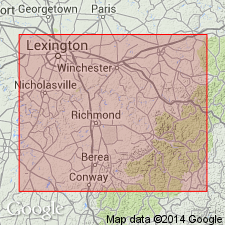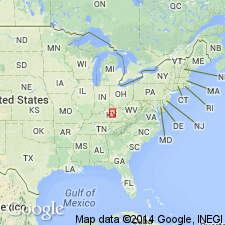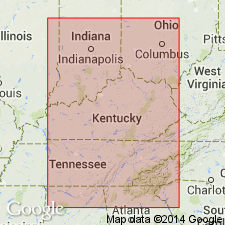
- Usage in publication:
-
- Greendale bed
- Modifications:
-
- Original reference
- Dominant lithology:
-
- Limestone
- Clay
- Shale
- AAPG geologic province:
-
- Cincinnati arch
Summary:
Pg. 10, 19, 211. Greendale bed of Cynthiana formation. Name suggested by J.M. Nickles for argillaceous limestones interbedded with calcareous clays and clay shales, constituting lower part of Cynthiana formation. Overlies Perryville (top division of Lexington formation) and underlies Point Pleasant division (named by Orton) of Cynthiana formation, which is characterized by distinctly less argillaceous material and by presence in some localities of 80 percent of calcium carbonate and 12 percent of magnesium carbonate, with very little silica or alumina, but along Ohio River the siliceous material in limestones at top of Cynthiana formation is increased to 10 to 20 percent. Thickness of Cynthiana formation 40 to 90 feet. [Thickness of subdivisions not stated. See also under Nicholas limestone.] Age is Middle Ordovician (Trenton).
Origin of name not stated by author, but probably named from Greendale, Fayette Co., central northern KY.
Source: US geologic names lexicon (USGS Bull. 896, p. 865-866).

- Usage in publication:
-
- Greendale Lentil*
- Modifications:
-
- Revised
- AAPG geologic province:
-
- Cincinnati arch
Summary:
Designated Greendale Lentil and assigned to the Lexington Limestone. Composed of irregularly-bedded to nodular fossiliferous limestone and shale. Thickness ranges from 0 to 15 ft. Entirely enclosed in Tanglewood Limestone Member of Lexington Limestone. Occurs only in small area in central Kentucky about 5 miles north of Lexington.
Source: GNU records (USGS DDS-6; Reston GNULEX).

- Usage in publication:
-
- Greendale Lentil*
- Modifications:
-
- Overview
- AAPG geologic province:
-
- Cincinnati arch
Summary:
The Greendale Lentil of the Lexington Limestone consists of olive-gray to light-gray, fossiliferous, argillaceous calcisiltite interbedded with thin shale beds. Unit is 75 percent limestone and 25 percent shale. Thickness is 10 to 15 feet. The lentil is restricted to the area immediately northwest of Lexington, KY and is completely surrounded by the Tanglewood Limestone Member of the Lexington Limestone.
Source: GNU records (USGS DDS-6; Reston GNULEX).
For more information, please contact Nancy Stamm, Geologic Names Committee Secretary.
Asterisk (*) indicates published by U.S. Geological Survey authors.
"No current usage" (†) implies that a name has been abandoned or has fallen into disuse. Former usage and, if known, replacement name given in parentheses ( ).
Slash (/) indicates name conflicts with nomenclatural guidelines (CSN, 1933; ACSN, 1961, 1970; NACSN, 1983, 2005, 2021). May be explained within brackets ([ ]).

